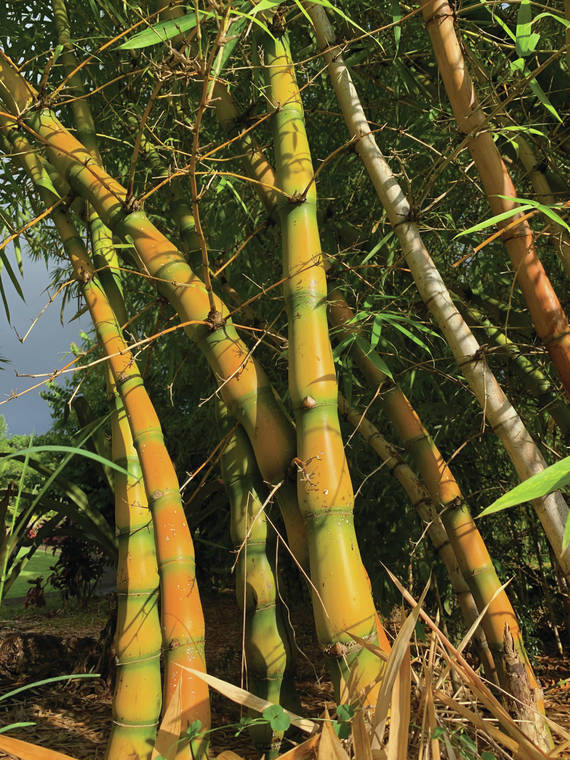COVID-19 has really restricted our lives, but here is a fun trip to consider this coming weekend. Quindembo Bamboo Nursery in North Kohala is inviting folks to visit their impressive bamboo collection planted on 20 acres of old sugarcane and pasture land. It is sort of an open house nursery style that starts Friday and continues through Sept. 6. This will give you a sense of how some of these fabulous clumping bamboos will grow in a relatively short time and maybe how you might incorporate some of these species into your own landscape.
Peter Berg and Susan Ruskin have imported over 100 species of noninvasive clumping bamboos. These are suitable for privacy hedges, gorgeous landscape statements, edible shoots, windbreaks and some even for construction. It is just the right time to visit and meditate as some species will grow from one to two feet in a single day. With patience one can actually watch them reach upward for the light.
They will have a great selection of plants for sale at discounted prices so bring a truck to take advantage of this special opportunity. Bamboos with exotic names like tropical blue angel mist, weavers’ bamboo and wamin are just a few. To see a list with descriptions check out their email at sales@bamboonursery.com.
Since directions are a bit complicated, email sales@bamboonursery.com or call Peter at 987-6452 for full information.
Hawaii’s varied climates and cultural makeup are ideal for bamboo, but until the 1980’s, there was no serious effort to introduce the valuable elite bamboos of Asia and the Americas. Thanks to the Hawaii Chapter of the American Bamboo Society and Quindembo Nursery, we now have many species from which to choose.
Bamboos have been used in Chinese gardens since 2000 BC. In the later centuries leading up to AD 1000, the Japanese started trading with China and many species were naturalized in Japan to enhance the gardens of temples and those of wealthy traders. The first recorded introduction to the West was Black Bamboo (Phyllostachys nigra) in 1827. In the 20th century, many species were introduced by USDA Experiment Stations in Puerto Rico and Louisiana with hopes to develop new crop potentials. From there, they were distributed throughout North and South America.
Valuable bamboos species from Asia were established, tested and distributed throughout the Caribbean and Central America over the next few decades. Today scores of species are utilized, but bamboo is not new to indigenous American Cultures. Guadua species native to the Americas were used as early as 9,500 years ago.
Asia is the ancestral home of many kamaaina, both people and plants. When it comes to plants, one of the most valuable of these is bamboo. Although there are many species found in central and South America, tropical and subtropical Asia has utilized bamboo for thousands of years. It is said that bamboo and rice are the very foundation of these cultures. The Hawaiian Ohe Kahiko, may be found in many parts of Polynesia. The actual genus and specie is not clear with taxonomists and botanists not all agreeing. We do know that it is a tropical clumper probably originating in Southeast Asia. It is likely Schizostachyum and has been called S. glaucifolium in Hawaii. There are vast stands in the mountains of high islands like Raiatea in the Society Islands. Polynesians there still use it in crafts.
With large tracts of land now available for forestry, and our local interest in sustainable agriculture, bamboo may become one of our major resources. It has many uses, both commercial and ornamental.
Even though bamboos are excellent sources of edible shoots and construction material, most folks are interested in ornamental bamboos for their beauty. Bamboos, of one type or another, are a natural for almost any tropical garden. In fact, many of the hundreds of types do grow in the tropics, but some species grow as far north as New York or Seattle, and can be found growing up to 10,000 feet in the mountains of Asia, Central and South America. Bamboos vary from forest giants of 120 feet to dwarfs of 6 inches. The clumping bamboos are ideally suited for ornamental uses in their area of adaptation. They can be planted in groups for hedges or singly for specimen plantings. They spread very slowly and are easy to keep within bounds. One of the best for sunny locations is the Mexican weeping bamboo. Others to consider are the Bambusa multiplex forms such as Alphonse Karr, fern leaf, silver stripe and feather bamboo. These delicate clump types range from 10 to 20 feet high. Other rare clumping types are beginning to show up in our nurseries like the chusqueas, and Buddha’s belly bamboo (Bambusa vulgaris wamin).
For larger gardens, try Bambusa chungii (tropical blue) and Weaver’s bamboo. There are several other bamboos also available. These are all clumping types in the 20- to 40-foot range with fancy Latin names and multiple uses.
The giant tropical clumping bamboos need plenty of room since they soar from 50 to 100 feet under ideal conditions. This group includes the larger Bambusa, Dendrocalamus, Guadua, and Gigantochloa species that may have culms 6 to 12 inches in diameter. They are grown for edible shoots, construction material, windbreaks and furniture. Favorites are the black culm types like Hitam, Lako and Gigantochloa atroviolecea. Another favorite spectacular giant is Dendrocalamus brandisii.
Bamboos do best in a moist well drained soil with some organic matter. Apply complete fertilizer such as organic 8-8-8 or manures four to six times a year to the planting. Mulch the soil around the planting. Mulches add organic matter to the soil, help to restrict the growth of weeds and conserve soil moisture. Dead leaves or dry grass clippings can be used for mulch. Apply a layer of mulching material at least 3 inches deep.
For further information on bamboo, call the University of Hawaii College of Tropical Agriculture and Human Resources Master Gardeners at 322-4893 in Kona or 981-5199 in Hilo.



